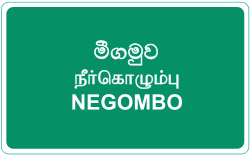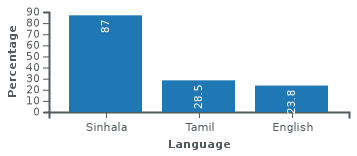Languages of Sri Lanka
Several languages are spoken in Sri Lanka within the Indo-Aryan, Dravidian and Austronesian families. Sri Lanka accords official status to Sinhala and Tamil. The languages spoken on the island nation are deeply influenced by the various languages in India, Europe and Southeast Asia. Arab settlers and the colonial powers of Portugal, the Netherlands and Britain have also influenced the development of modern languages in Sri Lanka.
| Languages of Sri Lanka | |
|---|---|
 A road sign in Sinhala, Tamil and English | |
| Official | Sinhala, Tamil |
| Foreign | English |
| Signed | multiple sign languages |

Native and indigenous languages
As per 2016, the Sinhala language is mostly spoken by the Sinhalese people, who constitute approximately 74.9% of the national population and total about 16.6 million. It uses the Sinhala abugida script, which is derived from the ancient Brahmi script. About 300 of the Veddah people, totaling barely 2,500 in 2002,[2] speak the Veddah language, of which the origin is debated. The Tamil language is spoken by Sri Lankan Tamils, as well as by Tamil migrants from the neighboring Indian state of Tamil Nadu and by most Sri Lankan Moors. Tamil speakers number around 4.7 million. There are more than 40,000 speakers of the Sri Lankan Malay language
Official Languages
in 1987 the Thirteenth amendment to the Constitution was introduced. It stated that, “the official language of Sri Lanka is Sinhala” while “Tamil shall also be an official language,” with English as a “link language”. Most official government functions are carried out in three languages, while Sri Lankan airline is probably the only international carrier that uses Tamil as one of its languages. In Parliament, legislators may make speeches in Sinhalese, Tamil or English. However, Tamil politicians complain that there is inadequate government services available in Tamil in their areas, as a continuing legacy of the divisive politics of Language that has plagued the country since its independence from the British in 1948. Language politics was aggravated by the "official languages act" of 1956 which made Sinhalese the official language, while a "reasonable use" of Tamil was legislated subsequently. However, this lack of services in the minority language is a problem in many multi-lingual countries. For instance, while French is an official language on par with English in Canada, French services may be very hard to find in many parts of Ontario or Alberta although billions of dollars have been spent over many decades.
Languages of foreign origin
(click to see full view of memorial plate)
English in Sri Lanka is fluently spoken by approximately 23.8%[3] of the population, and widely used for official and commercial purposes. It is the native language of approximately 74,000 people, mainly in urban areas. A handful of the 3,400 people of Portuguese descent speak Sri Lankan Portuguese creole.[4] The Muslim community in Sri Lanka widely uses Arabic for religious purposes. Seldom used nowadays is Arwi, a written register of Tamil that uses the Arabic script and has extensive lexical influences from Arabic.
References
- "South Asia ::SRI LANKA". CIA The World Factbook.
- Veddah at Ethnologue (18th ed., 2015)
- "Sri Lanka – language". Retrieved 20 June 2014.
- Indo-Portuguese (Sri Lanka) at Ethnologue (18th ed., 2015)